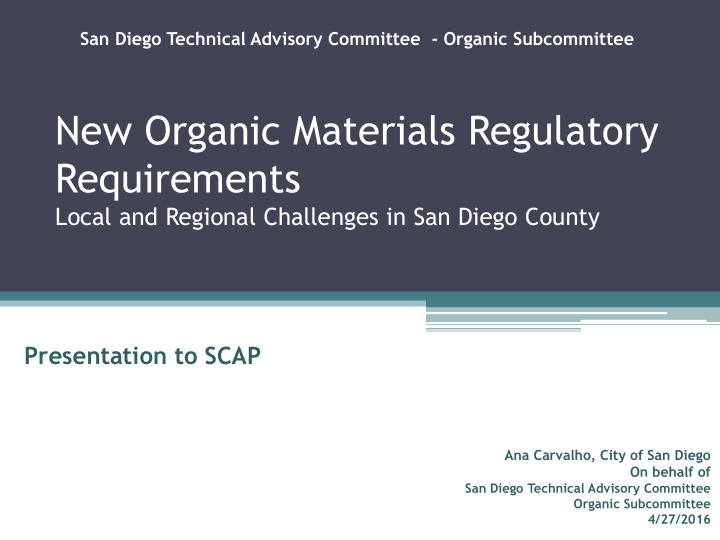



San Diego Technical Advisory Committee - Organic Subcommittee New Organic Materials Regulatory Requirements Local and Regional Challenges in San Diego County Presentation to SCAP Ana Carvalho, City of San Diego On behalf of San Diego Technical Advisory Committee Organic Subcommittee 4/27/2016
Disclosure This presentation was based on the TAC Organic Subcommittee presentation to the SDCCMA, presented on February 2016 by: Michael Wonsidler, County of San Diego Ana Carvalho, City of San Diego Colleen Foster, City of Oceanside
Regulations and Goals Nationwide • EPA - Reduce organic material disposal 50% by 2030 State • AB32 - California Global Warming Solutions Act • AB341 - 75% Waste Diversion by 2020 • AB 1826 - Commercial Organics Jurisdictions Zero Waste Plans • Climate Action Plans •
AB 1826- Commercial Organics Commercial Facilities Multi-Family Dwellings • Food Scraps • Yard Trimmings • Food-Soiled Papers • Grass Clippings • Yard Trimmings • Untreated Lumber • Grass Clippings • Untreated Lumber
AB 1826- Commercial Organics
AB 1826- Commercial Organics Average Restaurant Food Waste Generation 1.5 lbs/meal ~2,600 meals/week ~371 meals/day 1lb/meal ~4,000 meals/week ~ 571 meals/day 0.5 lbs/meal ~8,000 meals/week ~1,142 meals/day
2012 City of San Diego Waste Composition Study, Miramar Landfill Food City 15% (~190,000 tons) 465,000 tons Countywide
National Environmental Protection Agency’s Food Recovery Hierarchy Backyard Composting Fat, Oils & Grease Small Scale Decentralized Composting Centralizing Composting & Anaerobic Digestion Source: EPA, http://www.epa.gov/smm/foodrecovery/
Example of Potential of Food Recovery Hierarchy in the City of San Diego Potential Diversion Source Reduction, Feeding People, Feeding Animals Overall Commercial Food Waste 80,000 tons Potential 5 % Source Reduction 4,000 tons Potential 10% Food Donation to People 12,000 tons Potential 15% Food Donation to People 12,000 tons Potential 10% Food Donation toAnimals 12,000 tons Potential 10% Food Donation to Animals 8,000 tons
Why Compost Carbon Replenishes soil healthier soils & plants Carbon Reduces landfill leachate Carbon & GHG emissions Carbon H2O 2009 Landfills emitted ~6.7 MMTCO2e CARB GHG Inventory Sequesters carbon H2O from the atmosphere H2O Composting organics reduces H2O 0.42 MTCO2e per ton CARB GHG Inventory Carbon Retains water 1% Increase in organic matter = 25,000 gals H2O of available soil water/acre
Challenges Caution Magic Black Boxes Liquefiers End-product must prove that Potential problems with it is compost sewer line clogs Compost has to be tested according to State’s It is not considered diversion standards
Possible Solutions Anaerobic Digesters (AD) Wastewater AD Food Waste slurry fed • Perris into Wastewater being built Treatment Plant Digester 365,000 tons/year Increases energy • Convert food scraps, • production manures, etc. into Residual contains sewage • renewable energy sludge Residual can be • composted AD Joint Water Pollution Control Plant Carson, CA
Discussion/Questions? Thank you! San Diego TAC - Organic Subcommittee
Recommend
More recommend